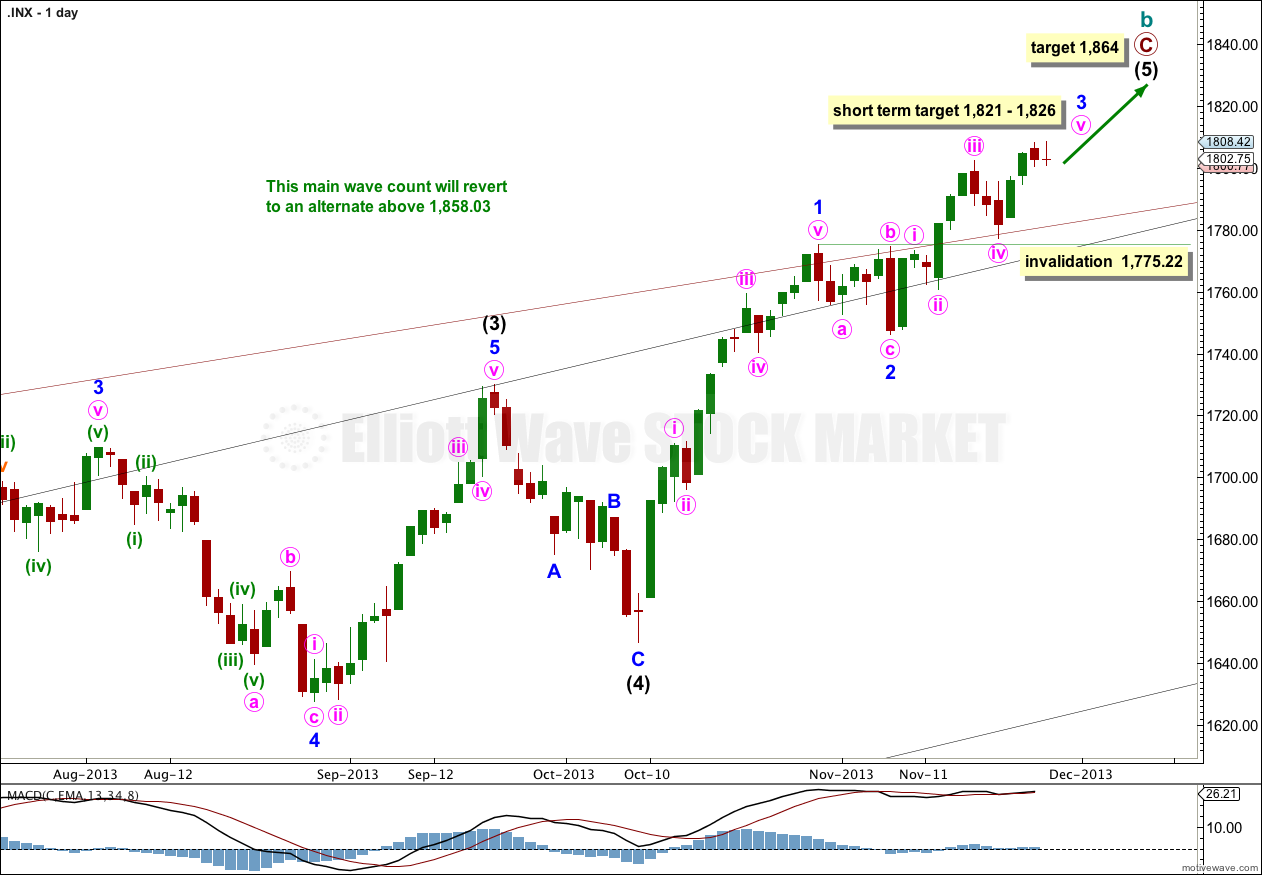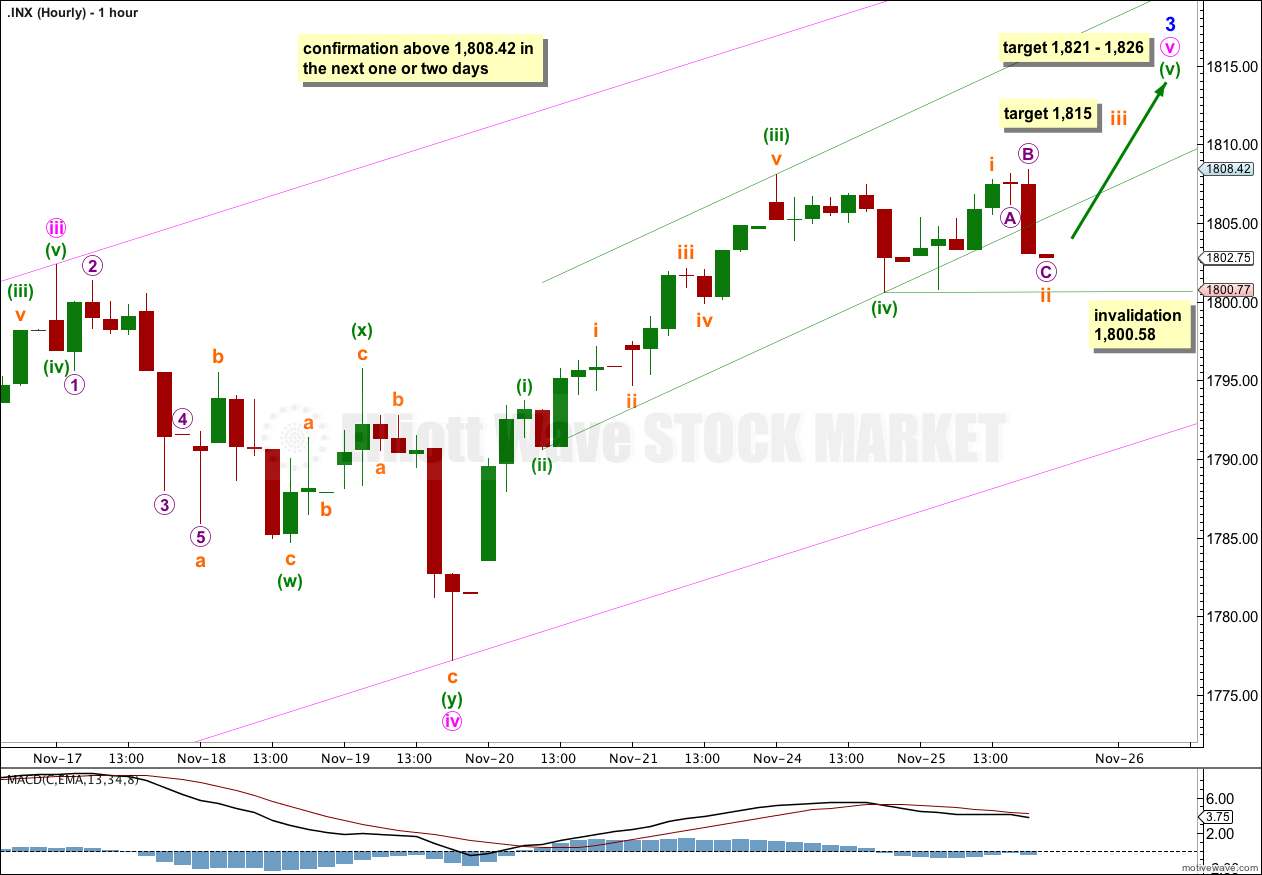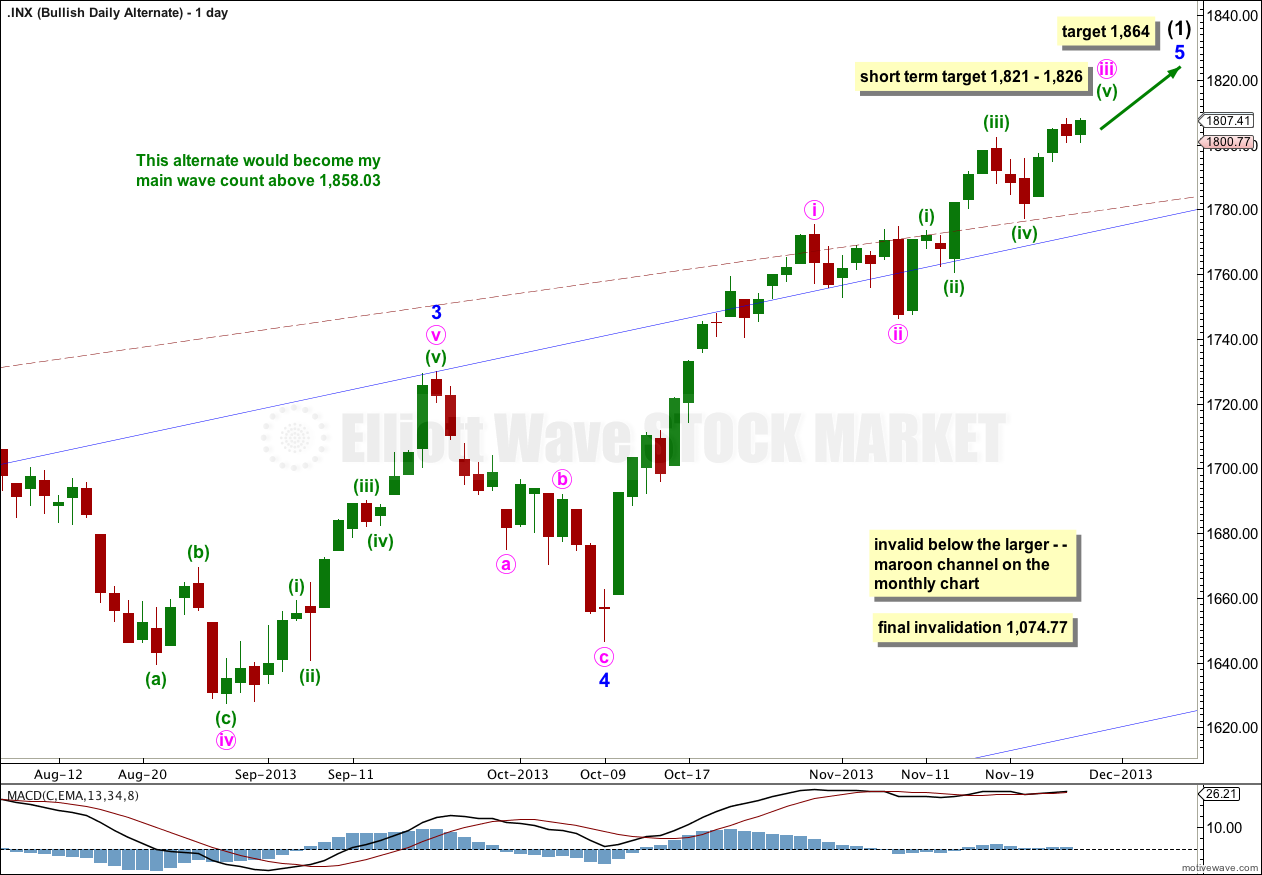Yesterday’s analysis expected more upwards movement from the S&P 500 for Tuesday’s session, which is how the session began. This upwards movement was followed by a deep correction so that the day ended sideways with a doji candlestick.
The wave counts remain the same.
Click on the charts below to enlarge.
Main Wave Count.
This wave count has a higher probability than the alternate. Upwards movement over the last 4 1/2 years subdivides best as a zigzag. If something is “off” about the supposed recovery then it must be a B wave because there is plenty that is off in this scenario in terms of social mood.
Downwards corrections may now find support along the upper edge of the big maroon channel from the monthly chart, if the upper trend line is pushed out to encompass all of primary wave A.
Intermediate wave (5) is incomplete, with minor waves 1 and 2 completed.
At 1,826 minor wave 3 would reach 0.618 the length of minor wave 1. Minor wave 1 is extended, so minor waves 3 and 5 may not be.
At 1,821 minute wave v would reach equality in length with minute wave iii.
At 1,864 intermediate wave (5) would reach equality in length with intermediate wave (1). This is the most common ratio between first and fifth waves so this target has a good probability.
It is possible now that minor wave 3 is over (see alternate hourly wave count below). Minor wave 4 may not move into minor wave 1 price territory. This wave count is invalidated with movement below 1,775.22.
Upwards movement labeled subminuette wave i within minuette wave (v) subdivides perfectly as a five wave impulse on the five minute chart.
The following deep correction may be a typical second wave as an expanded flat. The subdivisions fit nicely on the five minute chart. Within it micro wave B is a 152% correction of micro wave A, and micro wave C is so far longer than 4.236 the length of micro wave A. Within micro wave C it is not possible to see that the fifth wave is over. Movement above 1,804.90 would indicate the fifth wave within micro wave C is over, and at that stage I would expect subminuette wave iii has most likely begun.
I would expect to see an increase in upwards momentum over the next one or two days as a third wave unfolds. At 1,815 subminuette wave iii would reach 1.618 the length of subminuette wave i.
If subminuette wave ii moves lower tomorrow then it may not move beyond the start of subminuette wave i. This wave count is invalidated with movement below 1,800.58.
If price moves below 1,800.58 tomorrow then I would use the alternate hourly wave count below.
It is possible that minor wave 3 has ended much earlier than the target anticipated, and that strong downwards movement at the end of Tuesday’s session is the start of minor wave 4.
At the end of minor wave 3 minuette wave (v) may have ended with an ending contracting diagonal. This structure fits quite nicely on the five and one minute charts.
Minor wave 3 would have no Fibonacci ratio to minor wave 1. Minor wave 3 would be significantly shorter than minor wave 1, which would limit the final wave of minor wave 5 to no longer than equality with minor wave 3 at 62.22 points.
Ratios within minor wave 3 are: minute wave iii is 2.38 short of 1.618 the length of minute wave i, and minute wave v has no Fibonacci ratio to either of minute waves i or iii.
Ratios within minute wave v are: minuette wave (iii) is 1.02 points longer than equality with minuette wave (i), and minuette wave (v) has no Fibonacci ratio to either of minuette waves (i) or (iii).
A small breach of the parallel channel containing minute wave v may be an early indication that this wave is over.
If minor wave 4 has begun then I would expect it to end slightly above the end of the fourth wave of one lesser degree at 1,777.23. I would expect minor wave 4 to breach the parallel channel containing minor wave 3, but on the way down to initially find resistance there.
At this early stage, if this wave count is confirmed, then it is impossible to tell what structure minor wave 4 may take. The first downwards movement should subdivide as a five and be clearly visible as a five on the hourly chart. Within the first five down no second wave correction may move beyond the start of its first wave. This wave count is invalidated in the short term with movement above 1,808.42.
If minor wave 4 is a flat, combination or running triangle then it may have a new price extreme above 1,808.42, but this would not be for at least a few days.
Overall minor wave 4 should be choppy, overlapping and last at least a week. If it is a time consuming structure it may last about three weeks.
Alternate Wave Count.
It is possible that a new cycle degree bull market began at 666.79. So far it is not yet halfway through, and I would expect it to last for a few years (at least five more years and maybe longer).
At some stage then the current upwards impulse, labeled intermediate wave (5) for the main wave count and minor wave 5 for this alternate, will be completed. At that stage both wave counts would expect a trend change. The main wave count would expect a huge cycle degree trend change, and this alternate would expect an intermediate degree trend change. If the downwards movement subdivides as a three and remains within the maroon channel then this alternate would be preferred. If it breaches the channel this alternate would be discarded.
The maroon – – – channel is an acceleration channel drawn about primary waves 1 and 2 on the monthly chart (it is drawn in exactly the same way on the main wave count, but there it is termed a corrective channel). I would not expect intermediate wave (2) to breach this channel because a lower degree (intermediate) wave should not breach an acceleration channel of a higher degree (primary) first and second wave.
The daily chart shows the structure of minor wave 5. It is incomplete. Targets are the same because they are calculated using the same wave lengths as the main wave count. This bullish alternate does not diverge from the main wave count at this stage, and it will not for some weeks to come.




